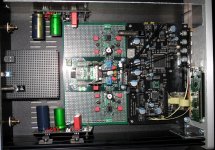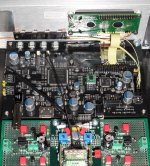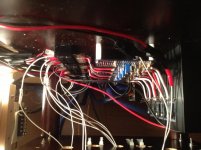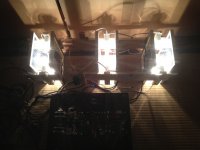... Is SDTrans384 still available for sale?
As of now, I have no further update on the explanation shown here.
http://www.diyaudio.com/forums/digital-source/142562-microsd-memory-card-transport-project-58.html#post3402422
Would you contact to Mr. Yamazaki of Tachyon?
Apple IR Remote kit for SDTrans384
Mr. Yamazaki of Tachyon announced a release of Apple IR Remote kit for SDTrans384 on his blog page.
?????blog SDTrans384????????
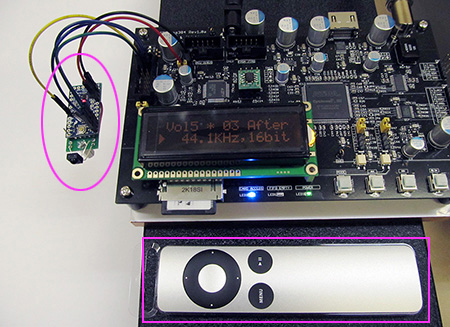
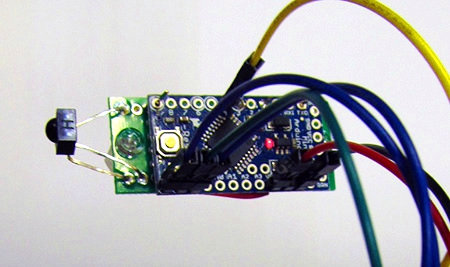
The small board marked with a pink circle contains an Arduino board.
A domestic price is 9,800 JPY. The kit includes Apple IR Remote device.
Please contact to the following address.
jack <at> mtc <dot> biglobe <dot> ne <dot> jp
Mr. Yamazaki of Tachyon announced a release of Apple IR Remote kit for SDTrans384 on his blog page.
?????blog SDTrans384????????


The small board marked with a pink circle contains an Arduino board.
A domestic price is 9,800 JPY. The kit includes Apple IR Remote device.
Please contact to the following address.
jack <at> mtc <dot> biglobe <dot> ne <dot> jp
Thank you for letting us know about this!
I have ordered one kit.
/S
I have ordered one kit.
/S
Mr. Yamazaki of Tachyon announced a release of Apple IR Remote kit for SDTrans384 on his blog page.
?????blog SDTrans384????????
The small board marked with a pink circle contains an Arduino board.
A domestic price is 9,800 JPY. The kit includes Apple IR Remote device.
Please contact to the following address.
jack <at> mtc <dot> biglobe <dot> ne <dot> jp
Firmware 3.25
Dear Bunpei:
I read that the firm ware to SDTrans384 is now 3.25.
Google Översätt
I am using only version 3.16 on my SDTrans with red LED. I plan to soon use Chiaki´s DAC PCB using dual ESS9018:s.
I think that many of us would be interested in knowing more about the differences between the firmware upgrades. Would it be possible t ask for a list with changes between each revision, and to know if any special hard ware is needed for that particular firmware revision?
How about the FPGA software - what is the latest version of that? Is any FPGA software linked to anys pecial firm ware version?
/S.
Dear Bunpei:
I read that the firm ware to SDTrans384 is now 3.25.
Google Översätt
I am using only version 3.16 on my SDTrans with red LED. I plan to soon use Chiaki´s DAC PCB using dual ESS9018:s.
I think that many of us would be interested in knowing more about the differences between the firmware upgrades. Would it be possible t ask for a list with changes between each revision, and to know if any special hard ware is needed for that particular firmware revision?
How about the FPGA software - what is the latest version of that? Is any FPGA software linked to anys pecial firm ware version?
/S.
Dear Bunpei:
I read that the firm ware to SDTrans384 is now 3.25.
Google Översätt
I am using only version 3.16 on my SDTrans with red LED. I plan to soon use Chiaki´s DAC PCB using dual ESS9018:s.
I think that many of us would be interested in knowing more about the differences between the firmware upgrades. Would it be possible t ask for a list with changes between each revision, and to know if any special hard ware is needed for that particular firmware revision?
How about the FPGA software - what is the latest version of that? Is any FPGA software linked to any special firm ware version?
Actually, I have no comprehensive table of version genealogies on FPGA programs and corresponding firmware.
At least after version 3.16, a support for 48kHz series DSD was added.
In general, there are two major FPGA program versions for a standard series and a sync-option series. Firmware version is FPGA version dependent.
If you want to obtain the latest version of firmware, would you please send your internet e-mail to Bunpei with the FPGA program version number?
The FPGA program version number is marked on a small round label attached on your EEPROM chip.
what is the price of a SDtrans and where can it be purchased from? thanks
Would you read and follow the post #604 on this thread?
remote control for sdtrans
I received the remote kit and had no trouble installing it. Works great and am happy to have the lazy way to control the player. Now I need to make a case for it. Anyone know what type of ribbon cable is needed to move the LCD so it can be viewed from the front?
I received the remote kit and had no trouble installing it. Works great and am happy to have the lazy way to control the player. Now I need to make a case for it. Anyone know what type of ribbon cable is needed to move the LCD so it can be viewed from the front?
Lucky you!
I have tried for 10 days to odrer the remote control kit but do not get any reply.
What email address did you use?
/S
I have tried for 10 days to odrer the remote control kit but do not get any reply.
What email address did you use?
/S
I received the remote kit and had no trouble installing it. Works great and am happy to have the lazy way to control the player. Now I need to make a case for it. Anyone know what type of ribbon cable is needed to move the LCD so it can be viewed from the front?
A Japanese SDTrans user, Ken, built a "solar battery panel" based power supply and connected it to SDTrans384. Bunpei had a chance to compare resultant sounds with that of a conventional power supply.

Bunpei could perceive a definite sound quality difference. The solar battery panel power supply gave clearer sounds. It reminded me of DSD sound characteristic.
The system consists of two panels, a shunt type regulator and Krypton bulb light sources.
The system achieves a complete galvanic isolation.

Bunpei could perceive a definite sound quality difference. The solar battery panel power supply gave clearer sounds. It reminded me of DSD sound characteristic.
The system consists of two panels, a shunt type regulator and Krypton bulb light sources.
The system achieves a complete galvanic isolation.
Clean solar energy provides clean sounding audio
Last night Bunpei turned up at my doorstep with a "solar power supply" in hand. I had previously received his phone call to ask if I would be interested in trying this power supply for my "Sync Option" SDTrans (normally powered by 3 or 4 x 1.5V D-cells) and a Fidelix Caprice DAC, that also has an optional Chiaki made receiver and clock board built in that is fed by 3 x AA style batteries. (I.e. this receiver/clock board is powered separately from the Caprice itself that runs on AC power). Besides, the normal clock built into the Caprice is disabled and its function is taken over by the 90MHz/98MHz clocks on the "Chiaki board".
So, after listening to various tracks in standard configuration (battery power) Bunpei set up the "solar power supply" that really looked like a little bright lamp. I would say about 30 cm tall, and 20 cm in each side direction. There were two solar panels facing each other, and I counted four "Krypton Light Bulbs" shining inside. Bunpei placed two CD-discs with the reflective side pointed inwards towards the light bulbs both at the top and at the bottom. He explained to me that the solar panels are natively 20V, but they have been "hacked" to deliver 10V which is then fed into a shunt regulator that brings the voltage down to 5V. Bunpei explained me that most of the energy is lost as heat; both from the lamps and from the regulator (I confirmed that everything was damned hot). He also explained me other things like that there is no capacitor whatsoever (and of course no battery) in this system. He said that the efficiency is only one (1) %. I think there was a bunch of other information as well, but I pretty much understood that this is "the purest of the pure" way to get a completely isolated 5V power source to your source component (SDTrans etc).
Well, "the proof is in the pudding", as they say. First step was to only power the SDTrans itself, while the receiver/clock board was still powered by batteries. I happened to have some really special line and phono preamplifiers (latest upgrade of Lyra Connoisseur including prototype power supplies) in my system for a limited period, and I also am using my favorite Kiso Acoustic HB-1 speakers that happens to be one of the most revealing "audio tools" I own.
At first listen it was clear that the sound quality had taken a rather BIG jump up, and it was clear that we were listening at a "new dimension", or a "new level" which raised the resolution to a very high plateau indeed. I was having GREAT FUN! Bunpei sat there with a suitable smile throughout and asked me for certain tracks or types of music he wanted to hear (he had not brought his own source materials, but we share many sources anyway.) I played David Sylvian (Nine Horses), Kari Bremnes, and also a bunch of Jazz like Freddy Hubbard, David Byrd, and a bit of Macy Grace. Paul Simon "Graceland" is also a good comparison source. I even threw in an SD card with U2 playing solid rock. And there were others... Honestly it became so fun to listen to music with the "solar power supply" that it was hard to stop ourselves from not giving a damn to make further changes, but just keep on playing more and more music.
After a while we disciplined ourselves and went to the next step of also powering the receiver/clock board. Ideally speaking (for isolation purposes) we should have has an additional "solar power supply" for this purpose, but since we only had a single one, we used a split feed to share the power.
Possibly because of lacking isolation, there were both 'goods' and 'bads' about this configuration. Possibly there was a bit fuzziness or smearing (we are talking at a VERY high level here, so it is not like anything really collapsed), and we noticed a certain diffusion of energy. After going back to battery power for the receiver/clock card, and continuing to feed the SDTrans only from the "solar power supply" we preferred this for now, - but the appetite for going further by adding another "solar power supply" at a later date was awaken.
Since this was a borrowed unit, Bunpei had to remove it from my system (despite myself begging him to let it stay for at least a few days), and the fun was over.
I realize that this type of power supply hardly can be a commercial idea, and the 1% (only) efficiency is not really eco friendly. However, I can imagine a "movement" among DIY'ers that would like to try this out for themselves. I hope that Bunpei and friends will publish details so others can try.
Last night Bunpei turned up at my doorstep with a "solar power supply" in hand. I had previously received his phone call to ask if I would be interested in trying this power supply for my "Sync Option" SDTrans (normally powered by 3 or 4 x 1.5V D-cells) and a Fidelix Caprice DAC, that also has an optional Chiaki made receiver and clock board built in that is fed by 3 x AA style batteries. (I.e. this receiver/clock board is powered separately from the Caprice itself that runs on AC power). Besides, the normal clock built into the Caprice is disabled and its function is taken over by the 90MHz/98MHz clocks on the "Chiaki board".
So, after listening to various tracks in standard configuration (battery power) Bunpei set up the "solar power supply" that really looked like a little bright lamp. I would say about 30 cm tall, and 20 cm in each side direction. There were two solar panels facing each other, and I counted four "Krypton Light Bulbs" shining inside. Bunpei placed two CD-discs with the reflective side pointed inwards towards the light bulbs both at the top and at the bottom. He explained to me that the solar panels are natively 20V, but they have been "hacked" to deliver 10V which is then fed into a shunt regulator that brings the voltage down to 5V. Bunpei explained me that most of the energy is lost as heat; both from the lamps and from the regulator (I confirmed that everything was damned hot). He also explained me other things like that there is no capacitor whatsoever (and of course no battery) in this system. He said that the efficiency is only one (1) %. I think there was a bunch of other information as well, but I pretty much understood that this is "the purest of the pure" way to get a completely isolated 5V power source to your source component (SDTrans etc).
Well, "the proof is in the pudding", as they say. First step was to only power the SDTrans itself, while the receiver/clock board was still powered by batteries. I happened to have some really special line and phono preamplifiers (latest upgrade of Lyra Connoisseur including prototype power supplies) in my system for a limited period, and I also am using my favorite Kiso Acoustic HB-1 speakers that happens to be one of the most revealing "audio tools" I own.
At first listen it was clear that the sound quality had taken a rather BIG jump up, and it was clear that we were listening at a "new dimension", or a "new level" which raised the resolution to a very high plateau indeed. I was having GREAT FUN! Bunpei sat there with a suitable smile throughout and asked me for certain tracks or types of music he wanted to hear (he had not brought his own source materials, but we share many sources anyway.) I played David Sylvian (Nine Horses), Kari Bremnes, and also a bunch of Jazz like Freddy Hubbard, David Byrd, and a bit of Macy Grace. Paul Simon "Graceland" is also a good comparison source. I even threw in an SD card with U2 playing solid rock. And there were others... Honestly it became so fun to listen to music with the "solar power supply" that it was hard to stop ourselves from not giving a damn to make further changes, but just keep on playing more and more music.
After a while we disciplined ourselves and went to the next step of also powering the receiver/clock board. Ideally speaking (for isolation purposes) we should have has an additional "solar power supply" for this purpose, but since we only had a single one, we used a split feed to share the power.
Possibly because of lacking isolation, there were both 'goods' and 'bads' about this configuration. Possibly there was a bit fuzziness or smearing (we are talking at a VERY high level here, so it is not like anything really collapsed), and we noticed a certain diffusion of energy. After going back to battery power for the receiver/clock card, and continuing to feed the SDTrans only from the "solar power supply" we preferred this for now, - but the appetite for going further by adding another "solar power supply" at a later date was awaken.
Since this was a borrowed unit, Bunpei had to remove it from my system (despite myself begging him to let it stay for at least a few days), and the fun was over.
I realize that this type of power supply hardly can be a commercial idea, and the 1% (only) efficiency is not really eco friendly. However, I can imagine a "movement" among DIY'ers that would like to try this out for themselves. I hope that Bunpei and friends will publish details so others can try.
Last edited:
I'd like to express my sincere gratitude to elecon's very kind reporting.
I built my own Solar Cell Panel power supply for SDTrans384+Chiaki's ES9018 Dual Mono DAC. Three pairs of solar cell panels generate six independent +5V output for SDTrans, Clock section DAC, DVCC section L, DVCC section R, AVCC section L and AVCC section R.
Solar cell panel +10V raw DC output are regulated by simple TL431 + 2SA1941 based shunt regulators.
I believe I have obtained the best power supply system commensurate to Chiaki's DAC so far.
Resultant sound quality is very detailed and powerful at the same time as well as bright and clear. The PS meets digital, analog and clock sections.
I built my own Solar Cell Panel power supply for SDTrans384+Chiaki's ES9018 Dual Mono DAC. Three pairs of solar cell panels generate six independent +5V output for SDTrans, Clock section DAC, DVCC section L, DVCC section R, AVCC section L and AVCC section R.
Solar cell panel +10V raw DC output are regulated by simple TL431 + 2SA1941 based shunt regulators.
I believe I have obtained the best power supply system commensurate to Chiaki's DAC so far.
Resultant sound quality is very detailed and powerful at the same time as well as bright and clear. The PS meets digital, analog and clock sections.
Attachments
- Home
- Source & Line
- Digital Source
- MicroSD Memory Card Transport Project
